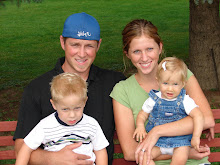Thursday, February 10, 2011
canvas lined cardboard box
Saturday, February 5, 2011
Fabric Flower
Today we have another fabric flower tutorial for the 31 Crafty Flowers in 31 Days !
This one is very similar to the fabric flower we made before but instead of pointed petals you get round petals.
Here's what you need to get started:
-Fabric
-Needle and Thread
-Scissors
-Buttons
Step One
Cut six 3x3 squares of fabric.
Step Two
Fold in a triangle shape, wrongs sides together and press.
Step Three
Stitch a loose gathering stitch around the open edges of the triangle.
Now gather the fabric into a petal shape by pulling the thread through.
Attach the next petal to the first and then stitch around the edges and gather. Repeat this for all five petals.
Step Six
Once you've finished gathering all your petals attach the last petal to the first petal to form the flower.
Step Seven
Add a button to the center and your pretty fabric flower is finished!
Try putting these on:
-tote bags
-journals
-barrettes
-a brooch
-a scrapbook cover
-a t-shirt
-a bulletin board pin
Friday, February 4, 2011
Coffee Filter Christmas Tree
You ever have those days where an idea just pops into your head? Jut out of nowhere? That's what happened with this Christmas tree craft! I was actually thinking about making some coffee filter angels with these natural coffee filters. That got me thinking about how you use the filter as a dress, and the ruffled look got me thinking about trees, and bam! There was the idea. Love that. :)
I have an entire box of these brown coffee filters, better known as natural coffee filters. I bought them when the store was out of Bunn filters. Regular filters just don't cut it for a Bunn though, they just aren't tall enough. I knew I could use them up sometime, so into the craft supplies they went.
I love the vintage look the natural coffee filters give to this tree. You could use old vintage buttons, but I chose red to add a bit of color. I had a couple of white flowers left over from another project, and used white round topped stick pins to use as ornaments as well. For the base, I used a round slice of wood I had left over from the rustic north woods ornaments I made last year.
Want to make one of these trees? You could even use white filters for a pretty white tree, or paint the filters with green water color paints for a green tree. If you paint the filters, they may lose some of their ruffle, so be prepared for that.
Coffee Filter Christmas Tree
designed by Amanda Formaro
printable version
You will need
foam cone
regular stick pins
9-10 natural coffee filters
white round topped stick pins
red buttons
2 white flowers glued back to back
scissors
hot glue gun
something flat for the base (optional but adds a little weight)
What you do
First, fold a few coffee filters in half and cut the center circle out.
Open a filter and place it over the top of the foam cone, like a ring, and bring it all the way down to the base of the cone. Use the stick pins to tack the filter to the cone, pushing the pins in at the top of the filter, not down by the ruffles.
Repeat this step, working your way up the cone.
When you get about half way up the cone you will need to trim a little off the filter ring. Since the cone will naturally get smaller toward the top, you will need less and less filter as you work upward. Just trim off what you don't need, but set those pieces aside and use them at the top of the tree.
Use one of the center circles that you cut out of the filters to cover the top of the cone, securing with stick pins.
To decorate the tree, push round topped pins into the tree in various places, but don't push the pin all the way in. This will allow the ruffles to look more natural. If you push the pin in all the way it will flatten the ruffles against the cone. So push the pin in halfway or three quarters of the way, then gently pull the filter toward you to hide the pin section.
Use hot glue to add buttons. I glued the two flowers together, back to back, so that either side of the tree had a flower face. Glue that to the top of the tree. Then just glue it to your base (I used a round slice of wood).


















